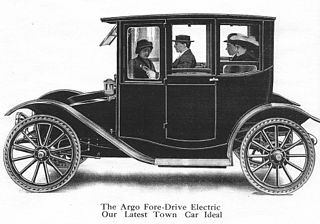
A Neighborhood Electric Vehicle (NEV) is a U.S. category for battery electric vehicles that are usually built to have a top speed of 25 miles per hour (40 km/h), and have a maximum loaded weight of 3,000 lb (1,400 kg). Depending on the particular laws of the state, they are legally limited to roads with posted speed limits of 35 miles per hour (56 km/h) or less. NEVs fall under the United States Department of Transportation classification for low-speed vehicles. The non-electric version of the neighborhood electric vehicle is the motorized quadricycle.

In the United States and Canada, low-speed vehicle (LSV) regulations allow relaxed design and registration laws for four-wheel vehicles that have a maximum capable speed of about 25 mph (40 km/h). Several other countries have similar regulations.

Crude electric carriages were first invented in the late 1820s and 1830s. Practical, commercially available electric vehicles appeared during the 1890s. An electric vehicle held the vehicular land speed record until around 1900. In the early 20th century, the high cost, low top speed, and short-range of battery electric vehicles, compared to internal combustion engine vehicles, led to a worldwide decline in their use as private motor vehicles. Electric vehicles have continued to be used for loading and freight equipment and for public transport – especially rail vehicles.

The Fiat Ducato is a light commercial vehicle jointly developed by FCA Italy and PSA Group, and mainly manufactured by Sevel, a joint venture between the two companies since 1981. It has also been sold as the Citroën C25, Peugeot J5, Alfa Romeo AR6 and Talbot Express and later as the Fiat Ducato, Citroën Jumper, and Peugeot Boxer, from 1994 onwards. It entered the North American market as the Ram ProMaster in May 2014 for the 2015 model year.
BYD Auto Co., Ltd. is the automotive subsidiary of BYD Company, a publicly listed Chinese multinational manufacturing company. It manufactures passenger battery electric vehicles (BEVs) and plug-in hybrid electric vehicles (PHEVs), collectively known as new energy vehicles (NEVs) in China. It also produces electric buses and trucks.

The Commuter Cars Tango is a prototype ultra-narrow electric sports car designed and built by Commuter Cars, an electric car company based in Spokane, Washington.

The CitiCar is a car produced from 1974 to 1977 by Sebring, Florida–based Sebring-Vanguard, Inc. After being bought out by Commuter Vehicles, Inc, Sebring-Vanguard produced the similar Comuta-Car and Comuta-Van from 1979 to 1982. Similarities to its exterior design can be spotted in the Danish Kewet and the later Norwegian Buddy electric car. Accounting for all CitiCar variants, a total of 4,444 units were produced up to 1979, the most since 1945 for an electric car assembled in North America until surpassed in 2011 by the Tesla.

The Henney Kilowatt was an electric car introduced in the United States of America for the 1959 model year. The car used some body parts as made for the Renault Dauphine. An improved model was introduced in 1960 with a top speed of 60 miles an hour and a range of 60 miles. Only 47 cars were sold over the two model years, mostly to electrical utility companies. Only a few still exist.
The Dodge EPIC was a concept electric car created by Dodge. The EPIC was first shown at the 1992 North American International Auto Show. EPIC stands for Electric Power Interurban Commuter.
Brammo, Inc. was an American producer of electric traction motors and traction batteries based in Talent, Oregon, United States. Brammo also developed and sold a range of electric motorcycles via the company's website and motorcycle dealers throughout the United States, Europe, and Asia.

ZENN is a two-seat battery electric vehicle that was produced by the ZENN Motor Company of Canada from 2006 to 2010, designed to qualify as a neighborhood electric vehicle (NEV). It had a range of up to 40 mi (64 km) and was speed-limited to 25 mph (40 km/h). On earlier production models, there was an option of a 'Discovery Pack' which increased the ZENN's range a few miles. In later models it was standard.
Hybrid vehicle drivetrains transmit power to the driving wheels for hybrid vehicles. A hybrid vehicle has multiple forms of motive power.

The Argo Electric Vehicle Company was an American electric automobile manufacturer that operated in Saginaw, Michigan, from 1912 to 1916. The Argo Electric used a 60 volt system with Westinghouse motors. They claimed to be capable of 20 mph (32 km/h). It had 6 forward and 6 reverse speeds, had 36 x 4 cushion tires and used an 18-inch (457 mm) steering wheel on the left. They were offered in both four- and five-passenger models, with open and closed versions available, and all models used steering wheels. The 110-inch (2,794 mm) wheelbase was the longest of any electric at the time. The Argo Brougham was a 4-passenger car, weighing 3,200 lb (1,451 kg), claimed a range of 75 miles (121 km) per charge using thirty 190 ah, MV Exide batteries.

The history of plug-in hybrid electric vehicles (PHEVs) spans a little more than a century, but most of the significant commercial developments have taken place after 2002. The revival of interest in this automotive technology together with all-electric cars is due to advances in battery and power management technologies, and concerns about increasingly volatile oil prices and supply disruption, and also the need to reduce greenhouse gas emissions. Between 2003 and 2010 most PHEVs on the roads were conversions of production hybrid electric vehicles, and the most prominent PHEVs were aftermarket conversions of 2004 or later Toyota Prius, which have had plug-in charging and more lead-acid batteries added and their electric-only range extended.
ENVI was a division of American automobile manufacturer Chrysler formed in 2007 to create electric-drive vehicles and related advanced-propulsion technologies.

A battery electric vehicle (BEV), pure electric vehicle, only-electric vehicle, fully electric vehicle or all-electric vehicle is a type of electric vehicle (EV) that exclusively uses chemical energy stored in rechargeable battery packs, with no secondary source of propulsion. BEVs use electric motors and motor controllers instead of internal combustion engines (ICEs) for propulsion. They derive all power from battery packs and thus have no internal combustion engine, fuel cell, or fuel tank. BEVs include – but are not limited to – motorcycles, bicycles, scooters, skateboards, railcars, watercraft, forklifts, buses, trucks, and cars.

Miles Electric Vehicles was a manufacturer and distributor of all-electric vehicles manufactured by FAW Tianjin in China that met international car safety standards. Miles was given the "Electric Car Company of 2007" award by Good Clean Tech. The company filed for bankruptcy on June 11, 2013.

The adoption of plug-in electric vehicles in the United States is supported by the American federal government, and several states and local governments.

Autonomous Fusion, formerly WHEEGO Technologies, is an American company headquartered in Atlanta, Georgia. WHEEGO develops vehicle technologies including: software, systems, tools for self-driving cars or autonomous vehicles, artificial intelligence/machine learning, and IoT connected devices for the home, business and roadway. The company is led by CEO Mike McQuary.

In China, the term new energy vehicle (NEV) is used to designate automobiles that are fully or predominantly powered by electric energy, which include plug-in electric vehicles — battery electric vehicles (BEVs) and plug-in hybrid electric vehicles (PHEVs) — and fuel cell electric vehicles (FCEV). The Chinese Government began implementation of its NEV program in 2009 to foster the development and introduction of new energy vehicles, and electric car buyers are eligible for public subsidies.























